Ask a question from expert
CHCDIV001 Work with Diverse People
23 Pages9279 Words888 Views
CHCDIV001 - Work with diverse people (CHCDIV001)
Added on 2019-10-09
CHCDIV001 Work with Diverse People
CHCDIV001 - Work with diverse people (CHCDIV001)
Added on 2019-10-09
BookmarkShareRelated Documents
CHCDIV001 - Work with diverse people
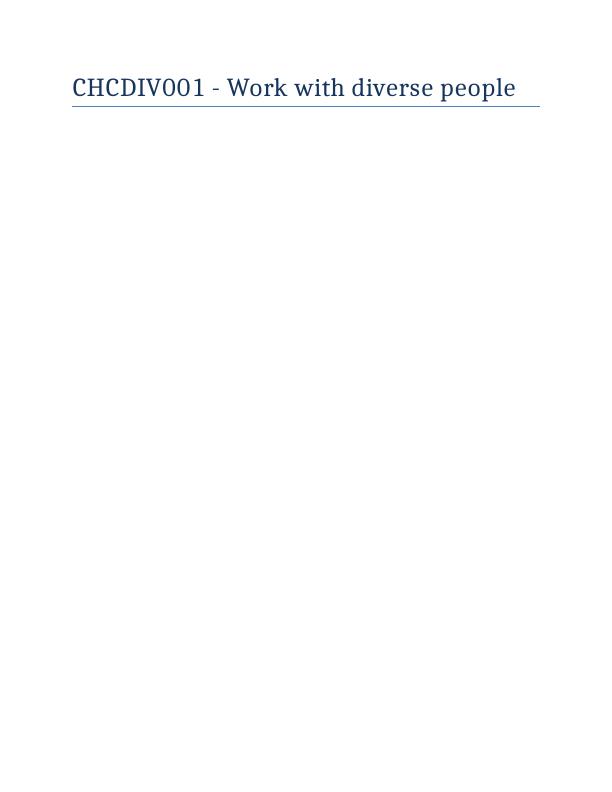
Formative AssessmentActivity 1Question 1 The modern workplaces deal with diverse group of clients and the workforces. Often the people fail tounderstand the values and beliefs of others. The lack of understanding prevents the individuals fromshowing respect and empathy to others (Betancourt et al., 2016). Therefore, the professionals workingin the modern childcare centers need to be culturally competent so that they can deal with the diversegroup of people effectively. Reflecting on own culture and beliefs is the first step of being culturallycompetent. When the people are aware of their own culture, identifying the similarities anddissimilarities becomes easier for them. In other words, knowledge on own culture helps the individualsto understand other’s cultures as well. It helps the individuals to be more culturally competent and meetthe requirement of people from diverse cultural group more effectively. Personal biases andstereotyped ideas are the other reasons that restrict an individual from being culturally competent.When an individual reflects on own biases, the reasons which lead to the biases, are revealed. As aresult, the individual becomes able to evaluate the neutrally whether the ideas are valid or not. It, inturn, helps the individuals to change the ideas positively. Elimination of personal biases enable people toavoid the issues due to cultural differences while dealing with others.Reference:Betancourt, J. R., Green, A. R., Carrillo, J. E., & Owusu Ananeh-Firempong, I. I. (2016). Defining culturalcompetence: a practical framework for addressing racial/ethnic disparities in health and healthcare.Public health reports.Question 2The awareness on self and the society can be increased in the following ways— Reading about own and other cultures can help an individual to understand the cultural differences and the values of others. Communicating with the people from diverse culture is effective to know them better and understand their beliefs effectively (Dunn & Andrews,2015).Assessing own biases can help an individual to get rid of misconceptions and increase the awareness on others. Cultural training can help an individual to develop the skills required by a global citizen and become more culturally aware.Reference:Dunn, D. S., & Andrews, E. E. (2015). Person-first and identity-first language: Developing psychologists’ cultural competence using disability language.American Psychologist,70(3), 255.
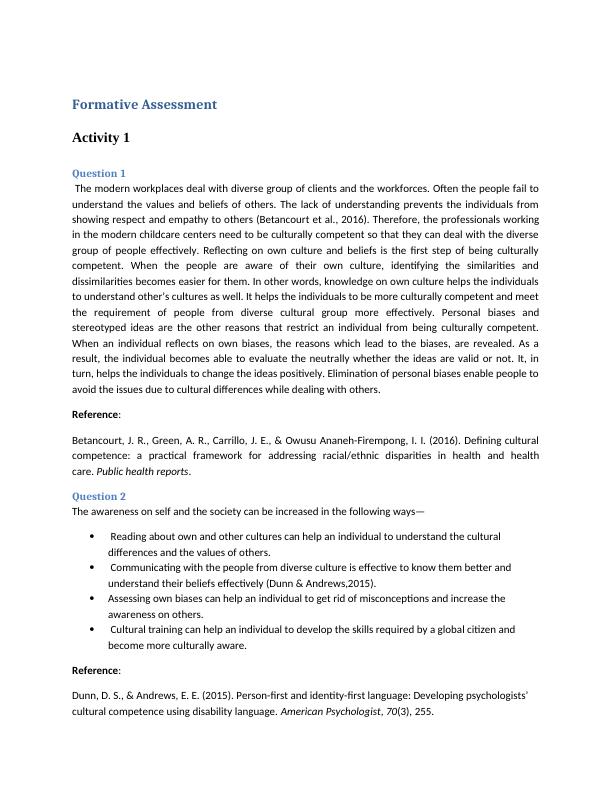
Activity 2Question 1An inclusive workplace is a working environment which puts value to the differences among the individuals and the groups within the workforce. The inclusive workplace enables an organization to manage the diverse workforce and use their talents, creativity and innovative ideas for growth of the organization. An inclusive workplace has the following characteristics –In an inclusive workplace, the diversity is accepted at every level of the organization. In aninclusive workplace, the diversity is observed not only in the workforce, but also among thecustomer population as well. The people in an inclusive organization are judged by their actionsonly, instead of the culture, race and other factors. In an inclusive workplace, the employees are communicated clearly about their roles andresponsibilities. Observable and measurable objectives are established to evaluate theperformance of employees. The employees in an inclusive organization are expected to puteffort for meeting their organizational objectives. The inclusive workplace does not show any bias to any employee on basis of their culture, age,race and gender (Garneau & Pepin, 2015). Transparent policies and procedures are enforced inthe inclusive organizations to ensure that the employees are not being discriminated any way. Inan inclusive organization, every employee is treated equally and in a consistent manner. The inclusive organizations focus on creating and maintaining the learning culture. Themanagement of an inclusive organization gives importance on encouraging and supporting thecareer development of all the employees. The formal and informal training systems are put inplace to ensure that the staffs are continuously developing themselves and behaving in theculturally competent manner. The inclusive organizations have well-established conflict resolution process in place. Theinclusive working environments consider that the conflict is inevitable in the multiculturalorganizations. So, these organizations have proper systems to address the conflicts in the non-confrontational manner without affecting the confidentiality and dignity. Reference:Garneau, A. B., & Pepin, J. (2015). Cultural competence: A constructivist definition.Journal of Transcultural Nursing,26(1), 9-15. Question 3 Strategies to enhance workplace diversity and inclusiveness: The organizations can use the following strategies to develop a diverse and inclusive workplace—

Educating the leaders-- The diversity in an organization needs to be incorporated at all levels and the role of leaders is effective in this case. When the leaders of an organization are aware ofthe diversity issues, implementing the multicultural environment would become easier. Making the leaders aware of the benefits of developing a diverse workforce encourages them to include all types of talents without any discrimination. Informing the leaders about the issues associatedwith diverse and inclusive workplace is effectively. It, in turn, can help the management to develop training programs for making the workforce culturally competent.Developing the individuals-- Incorporating diversity and inclusion in the workplace is acontinuous process (Shore et al., 2018). So, the management needs to develop the employeescontinuously to make the working environment diverse and inclusive. The cultural training canbe provided to the staffs so that their awareness on others’ values and beliefs increase. It, inturn, helps the management to reduce the cultural conflict and maintain an environment ofharmony at the workplace. Development of anti-discrimination policy-- Eliminating the discrimination towards theemployees on basis of the culture, race, gender or any other factor is the key to develop adiverse and inclusive workforce. The management of an organization needs to focus ondeveloping transparent rules and regulations in the organization so that all the employees getequal opportunities. Evaluating the employees on basis of their talent only help them toenhance the involvement with the organization. The merit-based and non-discriminative policiesalso encourage the staffs to contribute more for growth of the business.References:Shore, L. M., Cleveland, J. N., & Sanchez, D. (2018). Inclusive workplaces: A review and model.Human Resource Management Review,28(2), 176-189. Activity 3 Question 1 The physical safety at the childcare center can be ensured in the following steps— Each care center needs to have emergency exists and should comply with standard building codes to avoid accidents. The hazards in the care center need to be identified regularly and the care center is kept free from hazard. The care center is kept clean to reduce the hygiene related risks. The individuals who are suffering from any illness are kept isolated to reduce the risk of spreading germs. The employees of care center are provided with necessary equipments and gears to enhance safety at work. The care center is free from any sharp edges to reduce the risk of cuts and injuries.
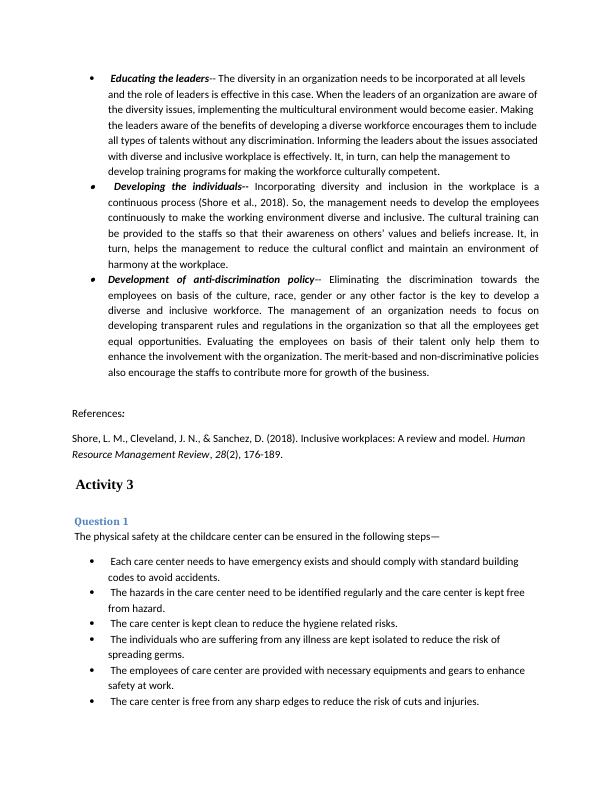
Question 2 The emotional safety in an organization can be ensured in the following ways—The care center ensures that none of the employees or clients is being discriminated because of their culture and other factors. The care center also ensures that every stakeholder in the care center is getting the chance to execute own cultural practices.Every client in an organization has unique needs. The care center ensures that emotional needs of every client are being addressed. Activity 4 Question 1The verbal and non-verbal strategies to show respect to the diversity at workplace are as follow—Verbal strategies:1.Speaking slowly and clearly while communicating with people from diverse language groups2. Using short and simple sentences3. Keeping the volume moderate4.Avoiding jargons at the time of communication5. Incorporating emotions to the communication6. Choosing the words wisely and ensuring that the vocabulary is not offensive to the audience Non-verbal strategies:1. Checking the body language and ensuring that it is compatible with the audience2.Considering the concept of persona space of the audience during communication 3. Ensuring that eye contact is done in appropriate manner during communication4. Considering social customs of the audience Question 2 The strategies which are used for developing trusted relationship with the clients are as follow— Giving importance on effective communication is a strategy to develop trusted relationship withthe clients. Effective communication fosters information sharing and so, helps an organization tomaintain transparency (Cao, 2017). Maintaining transparency is the key to develop trusted relationship with the clients.Acknowledging the needs of every individual client is another effective technique for developingthe trusted relationship. The organizations can focus on identifying the requirements of a client and developing the strategies for catering to the specific needs.Sharing knowledge with the clients leads to development of a transparent and trustworthy relationship.
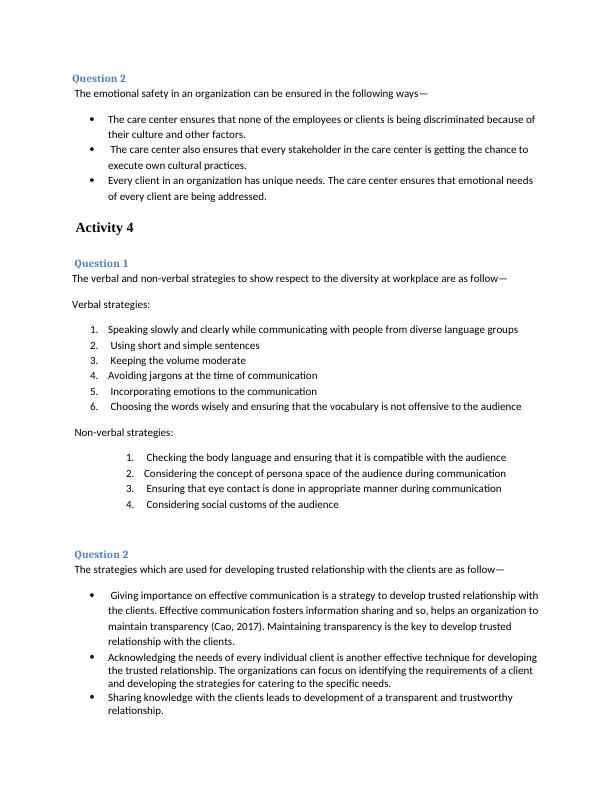
Reference:Cao, L. (2017, August). Behavior Informatics to Discover Behavior Insight for Active and Tailored Client Management. InProceedings of the 23rd ACM SIGKDD International Conference on Knowledge Discoveryand Data Mining(pp. 15-16). ACM.Activity 5 Question 1 The six communication barriers are—1.Differences in the languages2.Use of complicated words and sentence structure3.Lack of relevance of the message for the audience4.Inappropriate use of tone and facial expressions5. Differences in viewpoints and the perceptions6. The tendency of stereotyping prevents an individual from evaluating the messages obtained in a communication neutrally. So, the risk of misinterpretation becomes higher and the effectiveness of communication is affected. Question 2 Effective communication with the non-English speakers can be done in the following ways—1. Using some polite expressions during the communication can be effective develop close connection with the audience and initiate an effective communication.2. Using standard and simple English is an useful way to make the communication effective and easy to understand by the non-English speaking audience.3. Use of short and simple sentences is another effective way to make the audience understand the messages.4.Use of full sentences enhances the understandability of the messages.5. Taking help of an interpreter is also necessary for making the message easy to understand.6.Incorporating cultural sensitivity during communication assists the audience to understand the messages easily (Burgoon et al., 2016).7. Using correct pronunciation is effective to make the communication easier.8. Checking the audience frequently whether they understand the messages or not is another useful strategy for communicating effectively with the nom-English speakers (Moss, 2017). References:Moss, B. (2017).Communication skills in health and social care. Sage.Burgoon, J. K., Guerrero, L. K., & Floyd, K. (2016).Nonverbal communication. Routledge.
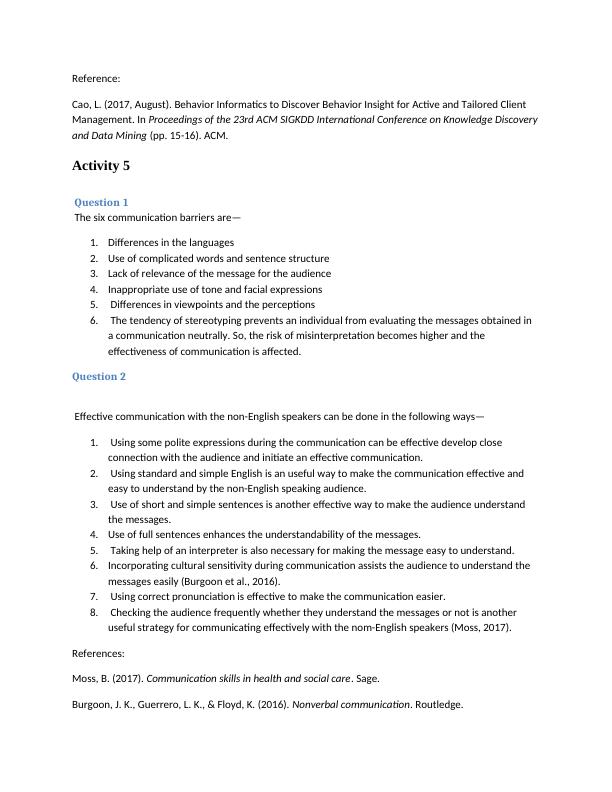
End of preview
Want to access all the pages? Upload your documents or become a member.
Related Documents
Disability and Social Inclusion Presentation 2022lg...
|24
|2902
|29
Introduction to Cultural Diversitylg...
|8
|1719
|76
Diversity in the Workplace: Assignmentlg...
|15
|1201
|89
Assignment on Diversity in the Workplacelg...
|12
|3224
|286
Cultural Competence in Health Carelg...
|3
|412
|48
Work With Divorce People Question and Answer 2022lg...
|10
|1912
|22